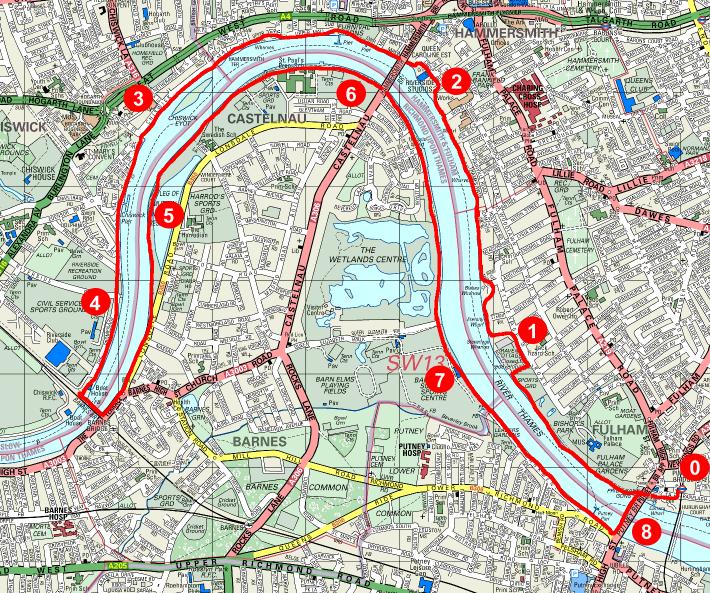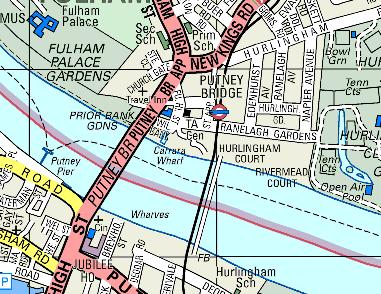The Railway Bridge (8.2 miles)
Route in figures |
Route Summary |
||||||
|
A flat, traffic free course. The first half, along the North bank of the Thames, takes you out of the suburbs of Putney and Fulham, past the stunning riverside houses of Hammersmith and Chiswick, Barnes Railway Bridge. The route back along the tow path on the South bank is a splendid trail run. For a longer route, see Route 5: The Boat Race. |
| "Digital Data © Geoinformation Group (2003)" |

Start and finish
|
The route starts and finishes at Putney Bridge tube station, on the District Line (Wimbledon branch), on the 39, 93 and 270 bus, or a 15 minute walk from Putney BR station. There is a cafe and toilets. There is nowhere here to leave your bags, unless you have a car or can persuade the people in Nancy's Cafe to look after them. |
"Digital Data © Geoinformation Group (2003)" |
Route details
| Mile | Directions |
| 0 | Turn left out of Putney Bridge Tube Station. Turn right into Ranelagh Gardens and left into Fulham High Street. Pass through a gate labelled "Willow Bank". Go through the underpass, labelled "Thames Path", under Putney Bridge. Go ahead into Bishops' Park, and then turn left towards the river. |
| 0.2 | Turn right at the river (the riverbank opposite is the start of the Oxford and Cambridge Boat race). Keep along the path by the river for ¾ mile. |
| 0.8 | Follow the path to the right when it reaches side wall of Craven Cottage, the football ground of Fulham FC. Follow the path to the gate out of Bishops Park, and turn left into Stevenage Road (not s/p). Keep the football ground on your left. |
| 1.0 | At the end of the football ground, turn left, labelled "Thames Path". Return to the river and turn right. Keep along the path for half a mile. |
| 1.5 | Just past a swing on the right, follow the path to the right (ie don't go up the steps in front of you). Follow the footpath ahead, with the pub on the left, under a metal trellis. Turn left onto the street. Go past Palace Wharf, and turn left down to the river, signposted to Dorset Wharf Community Centre. Turn right at the river. |
| 2.0 | Follow the path to the right and then left. Turn right onto Chancellor's Road (not s/p) and left into Crisp Lane, signposted to "Riverside Studios". Pass the Riverside Studios on the left, and turn left towards the river. Turn right at the river. |
| 2.2 | Pass under Hammersmith Bridge. Go ahead into Furnival Park. |
| 2.5 | At the end of the Park, by the jetty, turn right away from the river, then quickly left into a footpath running past the Dove pub. This opens out into Upper Mall. Run past the rowing clubs, and follow the path to the right at the Black Lion pub. Turn left into Hammersmith Terrace. This street becomes The Mall. |
| 3.0 | Swan House on the right. |
| 3.3 | At Chiswick Mall Public Drawdock on the left, in front of 1-7 Chiswick Mall, ignore the sign for pedestrians and bikes to go ahead and turn left through the gate with a sign saying "privately owned footpath". Turn right at the river. (When the gate is locked, go straight ahead.) |
| 3.6 | If you have followed the road rather than the footpath, after half a mile turn left at the roundabout towards a cuppola by the river and rejoin the route. |
| 3.6 | Just past the cupola, pass in front of the Pier Waterside Brasserie. Run along Thames Crescent, and out of the gate onto the Promenade. |
| 3.9 | As the path bears right, keep straight ahead along the grass, along a terraced embankment. |
| 4.0 | Pass in front of the derelict bandstand. |
| 4.2 | When you reach two signs at right angles, both labelled "Thames Path", decide whether to go over Barnes Railway Bridge or go further. To go over Barnes Railway Bridge, go straight ahead. Pass in front of Emmanuelle School Boat House, go up a few concrete steps, along a short muddy path, and up the steps on to the Railway Bridge. |
| 4.3 | On the other side of Barnes Bridge, come down the steps, cross the road and turn right. |
| 6.1 | Go under Hammersmith Bridge |
| 6.8 | Pass the monument to the right to Steve Fairbairn. |
| 7.7 | Pass Putney Pier on the left, and the Universities Stone marking the start of the Oxford and Cambridge Boat race. Follow the path up to the road, and up to Putney Bridge. |
| 7.8 | Turn left on Putney Bridge, cross the Bridge, and turn left down the steps on the other side. Go through the underpass and straight ahead. |
| 8.0 | The crest of Putney Bridge |
| 8.1 | Go through the gate labelled "Willow Bank" and turn right into Ranalegh Gardens. |
| 8.2 | Finish at Putney Bridge Station. |
Sights and history
|
As you come out of the underpass under Putney Bridge, glance to your right at All Saints Church. There has been a church on this site since 1400, though the current church was rebuilt in 1800. Fourteen Bishops of London are buried in the graveyard. Putney Bridge marks the start of the Oxford and Cambridge Boat Race, which covers the 4½ miles from Putney to Mortlake each spring. It was first raced in 1829 in Henley, moving to Putney in 1845. The start is marked by the Universities Stone on the South Bank. To the right is Fulham Palace. This was the summer residence of the Bishop of London from 704 to 1973. The palace dates from the 16th Century. The first magnolia to be grown in Europe was grown in the garden. Craven Cottage stadium is home to Fulham Football Club. It is named after an 18th Century cottage in Hammersmith, which burnt down in 1888. Riverside Studios in Hammersmith has been the home of two theatres and an art gallery since 1977. The building was originally an iron foundry, and was a BBC TV studio between the wars. Furnivall Gardens are named after Dr F J Furnivall, a 19th Century social reformer, whose sculling club was based by Hammersmith Pier. The sixteenth century Dove Inn is a famous London pub, which has held a licence for 400 years, though the present building is only two hundred years old. Charles II and Nell Gwynne met here. In the 18th Century it was a coffee house, where Thomson wrote the words to Rule Brittania in an upstairs room. Kelmscott House on Upper Mall was home to the poet and novelist George Macdonald, and then William Morris, who lived there from 1878 to his death in 1896. The front gardens along the river along Upper Mall are privately owned, but are open to the public once a year under the National Gardens scheme. The 17 houses along Hammersmith Terrace were built in the mid 18th century, when all around were fields, market gardens and strawberry fields. Sir Emery Walker, the antiquary and typographer who collaborated with Morris at the Kelmscott press, lived at no. 7. Sir Alan Herbert, the writer and advocate of the Thames, lived at 12 and 13. Chiswick Mall is one of the most attractive groups of 18th century houses in London. Walpole House was the home of Barbara Villiers, Duchess of Cleveland, Charles II's mistress, who died here in 1709. In the 19th century this became a school, with Thackeray among its pupils. Fuller's Griffin Brewery, on the right, is London's oldest brewery, dating back to the 17th Century. As you turn left at the blue sign, pause to look at the Charles Hadcock sculpture to your right, entitled Couplet. Behind it is the parish church of St Nicholas. The list inside traces the vicars of the church back to 1225. The tower dates back to 1436 - the rest was rebuilt in 1884, including the decorative windows. In the Cromwell family vault are three coffins, the shortest possibly holding the headless body of Cromwell, exhumed from Westminster Abbey and rescued from Tyburn in 1661. William Hogarth's grave is marked by a pedestal and urn with an epitaph by David Garrick. The tomb of the artist J M Whistler is nearby. Barnes retains a village atmosphere. Gustav Holst lived at No.10 before the first world war. The Bulls Head is one of London's best known jazz pubs. The terracotta Harrods Furniture Depository, a famous boat race landmark, dates back to 1890. It is now being converted into flats, as part of the Harrods Village development. Barn Elms Reservoir to the right is the site for a new wetland wildlife sanctuary to opened soon. There is a memorial stone, marking a mile from the start of the boat race, to Steve Fairbairn, oarsman and coach who founded the Oxford Head of the River race. Members of Ranelagh Harriers may be interested to know that the estate of Barn Elms, to the right, was the home for the fashionable Ranelagh Club from 1884 to 1939. Earlier in the 19th century, the grounds were used by William Cobbett for a variety of agricultural experiments, including growing maize. St Mary's Parish Church, at the bridgehead on the south side of Putney Bridge has been restored after a fire in 1977. The 15th century tower and chapel were preserved when the church was rebuilt in 1836. Oliver Cromwell held a council of war around the communion table here in 1647. Owen Barder |

